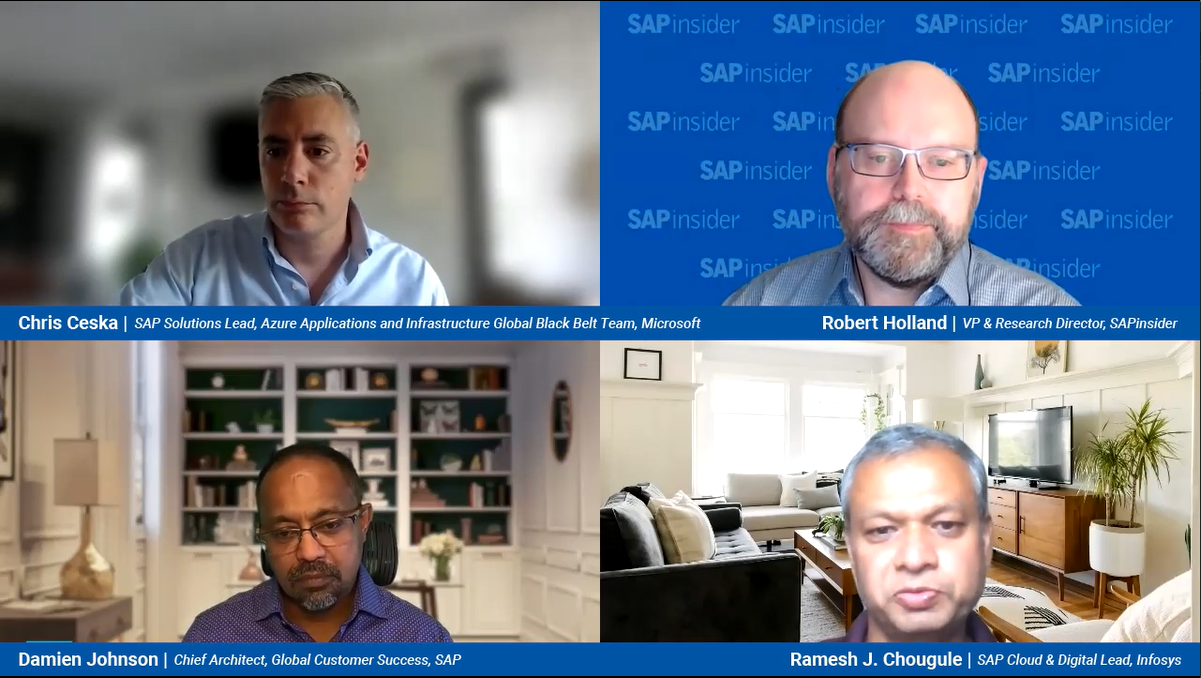Cloud Success Requires a Clear Vision
Infrastructure Change Alone Isn't Enough
By Robert Holland, VP and Research Director, SAPinsider
SAPinsider research has shown that 88% of our community are running at least some SAP workloads in the cloud, with more transitioning to that environment. But while there is a focus on the typical cloud goals of reduced operational costs, increased flexibility and scalability, and faster deployment of applications, taking the time to understand and define what ‘success’ actually means for your project is crucial.
The most significant factors driving cloud deployment strategy today are a business focus on digital transformation that requires cloud-based deployments and the pressure to modernize infrastructure to lower costs and simplify IT. Whether or not these are the challenges that your organization is facing today, the first step in defining cloud success is identifying the business problem you are trying to resolve and the business result you are trying to achieve.
Explore related questions
Are you replacing on-premise infrastructure with cloud infrastructure and looking to reduce costs? Are you moving from SAP R/3 or SAP ECC to SAP S/4HANA? In each instance, the organization must define the value that the business will achieve from this project.
For many companies, the goals are to increase revenue, reduce costs, and minimize risk. How will your project help you increase revenue? How will it reduce costs? Will it be secure and reduce risk?
Having the Right Conversations
To better understand how to define a successful cloud project and why that is important, SAPinsider sat down with Lee Johnson, Director of Sales Engineering at Virtustream. With over 20 years of experience working in the SAP ecosystem, Johnson has an enormous depth of knowledge about how to move SAP workloads effectively to the cloud.
“With any conversation or dialogue that I’m having with the customer, increasing revenue, reducing costs, and reducing risk are always on my mind. I’m looking at the transformation from that experience,” says Johnson. Having these conversations early in the process and focusing on them will help define success and how it will be measured.
The process should start with a deep dive or discovery. Customers that SAPinsider has spoken with have cited the benefits of taking this approach at the start of a transformation project. Johnson emphasizes the benefits of this strategy. “We go in and have that conversation with an executive to understand what success looks like for them,” Johnson says. “And it’s an iterative process. We have a conversation about their business once, two, or three times. What is it that we can help you to resolve today?”
Some organizations have taken the approach of bringing in a systems integrator or partner to help them complete this discovery process. This can add to the project’s overall cost but may offer benefits in having someone look at the organization from an external perspective. Johnson recommends that this process be performed with someone that the organization trusts — someone who is willing to fully understand what you’re trying to do and be honest about whether they can help achieve that goal.
This is important because every organization has different priorities. For some, it’s a move out of the data center to a total cloud experience. For others, it’s a proof of concept to see how a new solution like SAP S/4HANA will work. Understanding these priorities and having the right conversations are the starting points for mapping your path to cloud success.
‘Lift and Shift’ or ‘Move and Improve’?
Many of the customers that Johnson has assisted are working on infrastructure refresh initiatives. That can involve moving SAP applications to a cloud environment in what is often called “lift and shift.” But a more extensive cloud initiative can fit what Johnson calls “move and improve,” in which organizations are looking to do more than simply transition their on-premise workloads into a cloud environment.
Standard SAP environments typically include a development, test, and production instance for each system in use. Some organizations will also have a quality assurance (QA) system running in parallel to production, which is identical in every way. This can be used as a failover system in case of any issues, but it can be expensive from an infrastructure standpoint, even if the QA system does not have the same features as the production environment.
“In the past, you would typically see peak utilization happening once a month,” says Johnson. “When you’re closing the period, the box gets hit really hard. It might spike at different times throughout the day during that critical time, but for the most part if you averaged use over a 30-day cycle you would find that your infrastructure is not being utilized.” This is a challenge that organizations often face with internal infrastructure and why many consider a more flexible cloud model.
Johnson encourages organizations to ensure that they include disaster recovery (DR) as one of the instances that they need to be running. Even in cloud operating models, there must be a plan for DR because there are always the recovery point objective (RPO) and recovery time objective (RTO) that need to be met. In SAPinsider’s 2021 Enterprise Cloud Deployment report, we saw that 75% of respondents expect that cloud enterprise deployments will resolve their availability issues, demonstrating how important eliminating downtime and increasing resilience is to the SAPinsider Community.
You must consider whether you are simply looking to transition on-premise workloads into a cloud infrastructure so that you can reduce costs or if you are looking to complete a deeper transformation process. Regardless of which approach you take, Johnson says he focuses on reducing unplanned downtime and ensuring that the system has the resources it needs to perform when necessary.
Looking Beyond Cost Savings
Johnson says that the majority of customers he works with are looking at the cloud experience to reduce costs. In SAPinsider’s research, the pressure to modernize infrastructure to lower costs and simplify IT was the second most important driver behind a cloud deployment strategy. But Johnson argues that if you’re only looking at the cost component, you may be missing the bigger picture.
“What I believe our customers are trying to explore is what type of insights they can gain outside of their existing data,” Johnson says. This is where a cloud service can offer significant benefits as it will provide access to high-performance computing (HPC), data lakes, or other services that can leverage what you have in the cloud and connect it to data that can offer more insights. “At the end of the day,” Johnson continues, “you’re looking to enhance your customer’s experience whatever that might be. So when you couple the data you have internal to your SAP solution to data that you can harvest from other sources, you can really build that customer insight.”
This has the potential to result in an increased customer experience when clients are interacting with the organization. Having moved to the cloud, there is a foundation for future digital transformation. It can start with infrastructure modernization to provide high availability with lower lead times. This platform means that you can immediately act on new initiatives without waiting for infrastructure to begin.
Johnson always starts with infrastructure modernization, but for applications that can’t be modernized he recommends discussing refactoring those applications in the cloud. Organizations need systems of record, but these aren’t necessarily readily adaptable even when moved to the cloud. The goal is to discuss what you need today, but at the same time think about your needs for the future so that, whatever that future is, you aren’t constrained in the actions you need to take.
What Does This Mean for SAPinsiders?
Moving to the cloud is a common theme for organizations today as even older SAP workloads are potentially being moved onto refreshed infrastructure that will help reduce costs. But while there is more that can be leveraged from moving to the cloud, making that move successful requires an understanding of your goals. What are ways that can be more successful?
- Begin your cloud process by mapping your goals and objectives so that you can effectively define and measure success. Start your cloud process by having the right conversations with the right people. What do you want to achieve? What is needed to make that happen? A deep dive on your existing environment can be the starting point. The most successful cloud transformation projects identify all the processes, process flows, and requirements within the organization before putting in place any deployment plans. Taking this step will ensure that you have the right foundation for cloud success.
- Educate teams and spend time evaluating the different options that a move to a cloud environment represent. For IT and SAP Basis teams that have only used on-premise systems, it is essential to take the time to educate them on what working in a cloud environment can mean both from a technology and a landscape functionality perspective. This will allow teams to better understand and present the options that cloud environments represent to the business. Then, the difference between a lift and shift that may be transparent to end users and a move and improve that changes applications and processes as well as infrastructure can be better evaluated.
- Explore what the cloud can do beyond an infrastructure refresh and how you can fully leverage the capabilities that it provides. Having systems running in the cloud can be a significant advantage for organizations from a flexibility, scalability, and cost perspective. But these are only the starting points of what the cloud can offer to organizations. It is important that you spend the time to explore what you can do with your data once you’re in the cloud. Working with a partner like Virtustream, which has experience moving SAP workloads to both private and public cloud, is one possible approach. But whatever method you use, the maximum value of the cloud can only be achieved by fully understanding and leveraging your cloud investment.
About Virtustream
Virtustream, a Dell Technologies business, is an enterprise cloud and service provider that migrates and runs mission-critical SAP applications to private and public cloud environments. For enterprises, service providers, and government agencies, Virtustream’s xStreamCare Services™ expertise provides a personalized, high-tough approach to application and system modernization. Virtustream’s SAP-certified experts are backed by over 10 years of migration and management experience, featuring the completion of over 3,000 SAP migrations to date with 0 production rollbacks. As a result, the highest levels of availability, performance, security, agility, and efficiency in the cloud can be assured.







